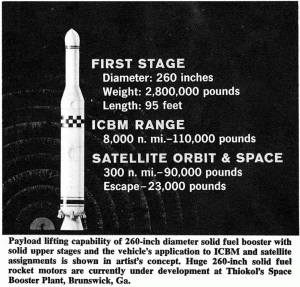Jun 162011
From this presentation comes an image (probably scanned from amagazine of the early 1960’s) showing a Thiokol concept for using a 260″ diameter solid rocket motor as the first stage of either a space launch vehicle or an ICBM. As a space launcher, it’s nothing special… 90,000 pounds into orbit. But as an ICBM with a range of 8000 nautical miles, the payload is an impressive 110,000 pounds. Which means either one truly hugenormous warhead, or a whole bunch of little ones. Like… a *hundred* little ones.
10 Responses to “260 Inches of Nuclear Whoopass”
Sorry, the comment form is closed at this time.

That sucker would be something to see coming out of a silo; the biggest thing the Soviets were working on was the N11GR, based on the top two stages of the N-1 booster:
http://www.astronautix.com/lvs/n11gr.htm
N11GR had to use a launch Pad to bring “fractional orbit bombing system” into Space
this 260″ ICBM “Monster” blast out a underground Silo, the bigges it they had build it…
the “Monster” could had launch TEN B41 nuclear bomb each 25MT = 250MT in total
General LeMay would be delighted…
I ran across some information on Thiokol’s bid for the 260″ solid rocket motor after reading about the Aerojet Dade site. Apparently these were under consideration for the first stage of Apollo in the early 60’s. Aerojet built a facility in the Everglades for testing, they’d never even consider that these days.
Here’s some stuff I turned up researching to 260″ motor project. I’ve been trying to get this information related to the relevant locations in wikimapia. (Thiokol test site – part 1, Thiokol test site – part 2)
Time, Friday, Mar. 12, 1965 – Space: Biggest Booster Yet
LIFE Apr 23, 1965
The 260 – The Largest Solid Rocket Motor Ever Tested
former Aerojet site in wikimapia.
The fact that these motors actually got built and tested makes me a bit giddy; and sad. They really used to think big back in the day.
more : I found another online source for a journal link that died on wikimapia.
Solid Rocket Enabling Technologies and Milestones in the United States JOURNAL OF PROPULSION AND POWER Vol. 19, No. 6, November–December 2003 , specifically the section titled “The 260-in. Motor”, pp 1056 and figure 12 on the same page. Note relative size of the technician standing on the beam in front of the motor, and the fact that the vast bulk of the motor disappears down into the silo. Which is in a swamp, in Florida. Crazee.But it a good sort of way.
OK, one more update.
Seems the Aerojet Dade site has attracted the attention of the urban exploration crowd.
trip report 1
trip report 2
Both include pictures of the (then) current state of the SL-2 test booster, which was abandoned in place in the test silo. I believe there’s another unit (SL-1, SL-3 ?) also stacked underneath it in the silo. Quite unusual to have a hole that deep in Florida, with the high water table.
You can find some more of this kind of amateur industrial archeology if you poke around online. I wanted to pass these on because they actually have pictures of the booster remains in situ in the silo.
It was quite the test; the exhaust products from it settled on cars that were near the test site and caused their paint to fall off due to its corrosive effects.
I’m intrigued by the things space capabilities. As a solid it ought to be a lot cheaper than most other launchers and it could be stored fully fueled indefinitely, either as a result of a ‘bulk booster buy’ or in case a quick launch was needed…ie space rescue. Two of them would exceed the payload of a Saturn 5 moonshot, so with a combination EOR/LOR mission profile it could be used for manned shots to the moon or mars.
Of course there is still that matter of 10 x 25 mt bombs…Thiokol has successfully weaponized awesome.
The reason the giant solids got developed was for use in a Saturn V first stage if they couldn’t get the F-1 engines to work correctly; they had a lot of problems with the F-1 early on, and were looking at a solid powered first stage as a back-up to keep the Moon program on schedule.
oops.. fail. Actually I was looking at the wrong Saturn, still impressive though.
Our answer to the CZAR Bomb equipped Proton I suppose.